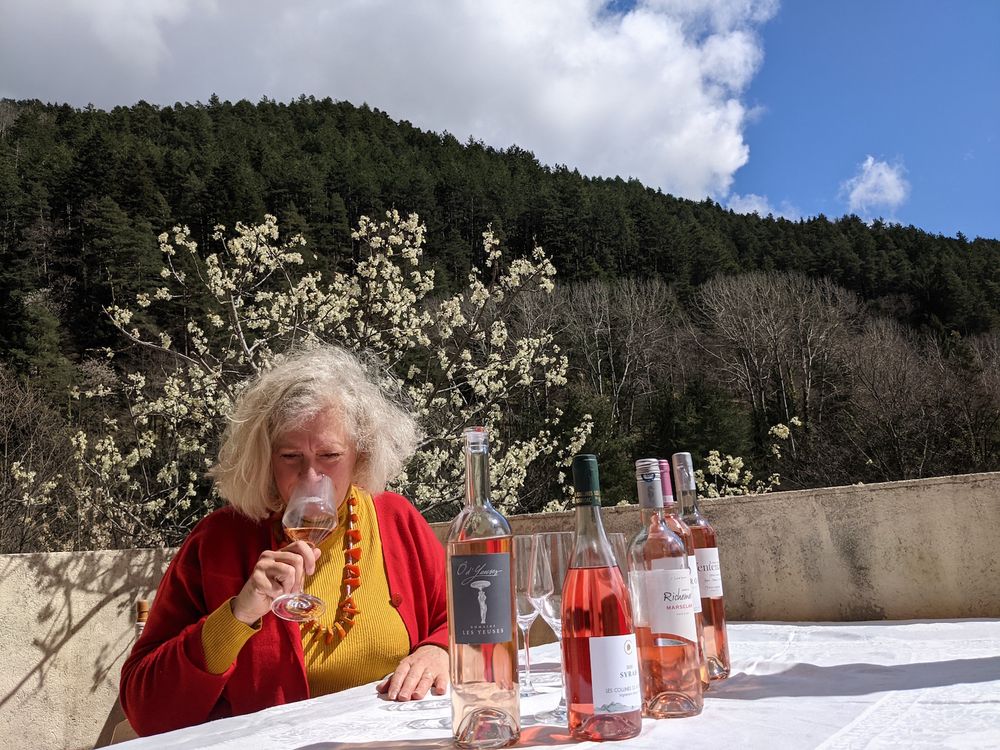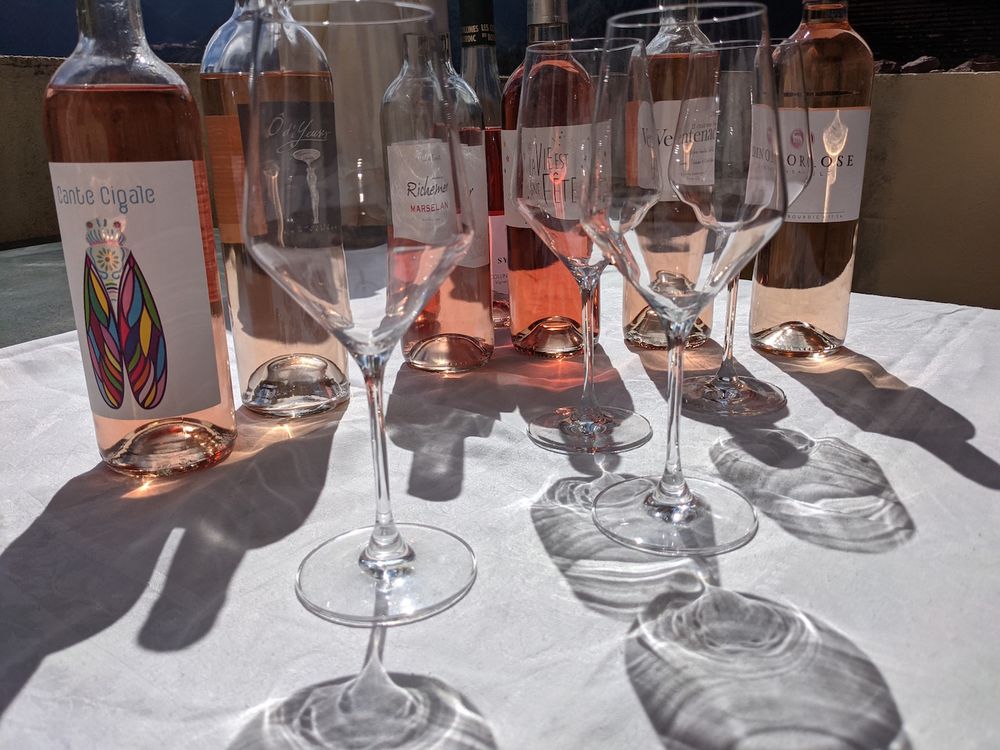“Far from being more of the same, Pays d’Oc IGP rosés are proving to be able to offer some intriguing diversity and are worthy of greater exploration,” writes Gabay.
With the Pays d’Oc IGP label producing the largest volume of rosé in France, from a vast geographical region, it should come as no surprise that there is a wide range of styles offering a diverse selection. Add to the mix the inclusion of 58 permitted varieties, this 2021 review of rosés includes both more conventional rosé blends, as well as an intriguing offering of varieties.
The 2020 vintage across southern France was hot and dry, resulting in many rosés being harvested a little earlier to retain freshness and a particularly delicate style.

Elizabeth Gabay MW tasting at her home in the South of France
Single variety rosés made from Grenache showed more creamy peach character than their usual redder fruit character. Calmel and Joseph’s Villa Blanche has creamy richness, peche de vigne with crisp redcurrant freshness and a satisfying weight and structure. Valensac’s Entre Nous has creamy custard and ripe peach with fresh loganberries with a gentle hint of phenolics, salinity and black pepper to give attractive complexity. Gerard Bertrand’s Gris Blanc has crisp white peach and apple, hints of lemon, a touch of orange zest and a whisper of minerality.
Delicate Cinsault rosés, reveal the variety’s characteristic floral notes. A pretty and vibrant example comes from Domaine de l’Herbe Sainte with summer flowers, sweet wild raspberries and strawberry sorbet and a touch of creamy richness. Les Collines du Bourdic’s Dino Rosé has honeysuckle with perfumed ripe white peach, exotic fruit and fresh acidity, its round ripeness gives weight and a hint of sweetness finishing with attractive spice and a twist of pepper. Joseph Castan’s l’Arnacoeur has a touch of Syrah in the blend. Pretty white peach fruit and crushed raspberries with a creamy richness and a vibrant acidity of lingonberry laciness. A mouth-watering finish and an underlying mineral structure give an elegant wine.
Vignerons du Sommiérois’ Chemin de la Pinède is a blend of the two varieties with juicy, crunchy redcurrant and cherries, creamy weight and refreshing acidity. It does everything, and it does it well. The inclusion of Syrah in the blend contributes a touch of weightiness and depth to the rosé and even blends of Grenache and Syrah work well.
Les Vignobles Foncalieu’s la Roseline has pretty sun-ripened redcurrant fruit, strawberries and cream, floral notes and a touch of bonbons anglaise backed by long acidity. Lovely and charming, crisp, moreish and very drinkable. Pierrick Harang Wine’s le Rosé de Balthazar has delicate red fruit, ripe richness with perfumed floral notes. Long fresh acidity giving a really zingy, creamy, full-bodied oomph on palate. Domaine les Yeuses’ la Gazelle has ripe strawberries and raspberries with the intensity of raspberry jam (with pips) and notes of sun-kissed cloudberries with ripe, smooth, creamy richness before finishing on notes of Mediterranean pine, garrigue and sage and long mineral acidity.
Adding Cinsault into the blend gives another dimension. Domaine La Provenquière’s Peché Coquin is Cinsault-dominant with lovely ripe creamy fruit with floral notes, white peach, green apple acidity. Simple, fresh, fruity and quite charming, the Grenache and Syrah contributing some hidden weight. Domaine Les Yeuses’ Ô d’Yeuses is a more even blend and is a lovely combination of the three varieties. White peach, marzipan, and some rather lovely mango ice cream lurking in the background gives almost voluptuous creamy ripe roundness with vibrant long fresh wild red berry acidity and a blue mineral core structure.
Syrah on its own gives slightly darker fruit. Domaine Lalaurie’s Syrah rosé has lush creaminess, juicy sour cherries, ripe redcurrants, dark, forest floor florals and a delicious intensity. The fruitiness is balanced by a firm mineral acidity with delicate herby phenolics on the finish making for a more serious, gastronomic style. Really lovely. Les Collines du Bourdic’s Syrah has charming wild strawberries, violet notes, abundant juicy mulberries and long, crisp crunchy acidity. An elegant saline steeliness on the finish of this dark fruit, and more complex rosé, makes it both joyful and serious.

Bordeaux blends give a touch of weight and intensity. Maison Ventenac’s Il était une fois, blends Grenache and Cabernet Sauvignon.Perfumed floral notes with deep jammy dark fruit, crunchy juicy red berries and vibrant refreshing length. Serre de Guéry’s Piété has gone for even more structure by blending Grenache with a quarter each of Syrah and Malbec. Initially deceptively soft with charming, juicy, sun-kissed ripe redcurrants and floral notes before revealing crisp, crunchy acidity, intense blueberries and some complex savoury notes: a delicious rosé for confirmed red wine drinkers. Delta Domaines’ Cante Cigale has, more unusually gone for 100% Petit Verdot, unusual for a rosé, but always impresses. Bountiful red cherries, strawberry jam and creamy richness with a counterpoint of salinity, this is beautifully joyful. La Belle Pierre’s Evidence combines Cabernet Franc with Caladoc (a Grenache and Malbec cross) in near even quantities. Floral, ripe, juicy peaches and long, ripe cranberry acidity, the red fruit continues to develop some serious weight and textural grip. A serious and refined gastronomic rosé. Marselan, another cross created by Paul Truel in the 1960s has Cabernet Sauvignon and Grenache parentage, and is on its way to be a big on-trend variety. Les Caves Richemer’s Marselan has lots of juicy cassis, ripe raspberries, redcurrants and floral notes, bursting with opulent freshness and a vibrant acidity of zingy, limes, oranges and satsumas.
The use of gris varieties gives pale pink with more white wine character. Domaine La Provenquière’s Pinot Gris has delightful quince, pear and apple compote with a creamy nutty richness, matched by a youthful greengage acidity. Les VignoblesFoncalieu’s Griset is made withSauvignon Gris. Round, rich, ripe white peach, with hints of red fruit and crisp, green apple and grassy acidity.
Last, but not least, cool climate Pinot Noir also gets a look in with Domaine du Siestou’s La vie est une fête (2019 toujour à la vente ?). Almost Burgundian with ripe cherries, almonds, hints of vanilla, fresh acidity, and a zingy touch of blood orange, this rosé is seriously classy.
Far from being more of the same, Pays d’Oc IGP rosés are proving to be able to offer some intriguing diversity and are worthy of greater exploration.










































